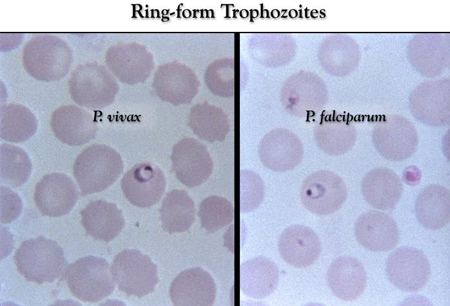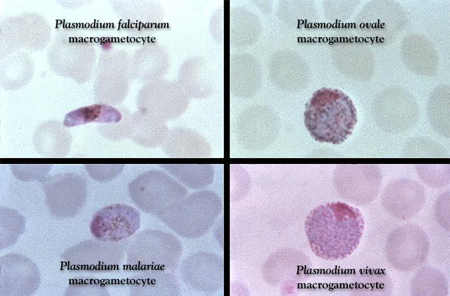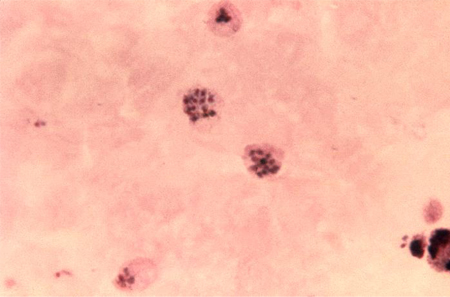Tests
1st tests to order
Giemsa-stained thick and thin blood smears
Test
Considered the test of choice to identify parasites.
The most common asexual form seen is the trophozoite. [Figure caption and citation for the preceding image starts]: Thin-film Giemsa-stained micrographs showing ring-form Plasmodium vivax and Plasmodium falciparum trophozoitesCDC Image Library/Steven Glenn, Laboratory & Consultation Division; used with permission [Citation ends].
In the case of Plasmodium falciparum, sexual forms infectious to mosquitoes, known as gametocytes, can often be seen and may persist in the blood even after effective treatment has ended.[Figure caption and citation for the preceding image starts]: Giemsa-stained slide revealing Plasmodium falciparum, Plasmodium ovale, Plasmodium malariae, and Plasmodium vivax gametocytesCDC Image Library; used with permission [Citation ends].
Thick films are more sensitive for detection of parasites than thin films, as they allow for a greater volume of blood to be examined. Nonimmune individuals may be symptomatic at very low parasite densities that may initially be undetectable. Therefore, if clinical suspicion is high, smears should be repeated daily on three separate occasions over 48 hours. Thin blood smears permit species identification and calculation of the parasitemia (percentage of parasitized red blood cells), both of which are necessary to determine appropriate treatment.[Figure caption and citation for the preceding image starts]: Thick-film Giemsa-stained micrograph showing two mature Plasmodium vivax schizonts, each containing merozoitesCDC Image Library; used with permission [Citation ends].
A high parasitemia (>2% of erythrocytes parasitized) is itself a sign of more severe disease, although severe disease may occur at any level of parasitemia. In addition, the presence of schizonts on the blood smear may indicate a patient with the potential to suddenly deteriorate.
Result
detection of asexual or sexual forms of the parasites inside erythrocytes
rapid diagnostic tests (RDTs)
Test
These immunochromatographic tests detect the presence of malaria antigen or enzyme and typically give a visible band after 15 minutes if positive.
Problems have included poor detection of species other than Plasmodium falciparum and false-negative results at lower parasite burden.[74][75][76] However, some studies have shown that performance of RDTs can be equivalent to expert microscopy.[77][78]
The main advantage of RDTs is that they provide a means for rapid diagnosis. This may be particularly useful in health resource-limited areas where microscopy is not available or reliable. Their incorporation into treatment algorithms may substantially reduce prescribing of antimalarials when compared with clinical diagnosis alone.[79][80]
[  ]
[
]
[  ]
]
A disadvantage of histidine-rich protein-2 (HRP-2) RDTs is their inability to distinguish between active infection and recently treated infection. Alternative devices using lactate dehydrogenase (LDH) and HRP-2 detection can identify active from treated infections. In addition, even with a positive HRP-2 RDT or pLDH RDT, a blood film is still necessary for confirmation of species (nonfalciparum) and for a parasite count to help guide treatment (falciparum and knowlesi). pLDH tests identify active infection. Another disadvantage is the emergence of pfhrp2/pfhrp3 gene deletions leading to false-negative test results in some areas (e.g., Horn of Africa).[81] False-negative test results may also occur in patients with very high parasite densities (the prozone effect), and this seems to be more common with HRP-2-based tests.[82]
One systematic review found that parasite LDH tests had a higher specificity, whereas the HRP-2 tests had better sensitivity and slightly greater accuracy, when compared with each other.[83] A combination of both tests, if possible, may be more reliable.
Ultra-sensitive HRP-2 tests have been developed and are more sensitive than standard HRP-2 tests.[84]
The World Health Organization recommends suspected false-negative RDT results should be investigated further.[81]
CDC: DPDx training - malaria RDT training video Opens in new window
Result
detection of parasite antigen or enzymes
CBC
Test
Thrombocytopenia is very common with Plasmodium falciparum infection, and platelet count may be very low. Despite this, bleeding complications are rare. Platelet counts typically recover quickly after treatment.
A mild degree of anemia is common with all species. Severe anemia is more common in children and is due to a combination of red cell destruction, autoimmune hemolysis, and disturbed marrow function.
White blood cell count may be high, low, or normal.
Result
may show thrombocytopenia, anemia, variable white cell count
clotting profile
Test
Bleeding complications are rare.
Result
prothrombin time may be moderately prolonged
serum electrolytes, BUN and creatinine
Test
Fever and volume depletion may lead to mild prerenal impairment, which responds well to rehydration.
Sodium is often low. A number of mechanisms have been proposed for this.[96] For example, administration of hypotonic fluids, syndrome of inappropriate antidiuretic hormone secretion, cerebral salt wasting, losses through sweat and the gastrointestinal tract, renal losses, and the sick cell syndrome. However, no consensus has been reached as to their relative contribution.
In severe malaria, renal failure may develop due to microvascular obstruction, filtration of free hemoglobin and myoglobin, volume depletion, and hypotension, with reduced urine output and proteinuria. The main histopathologic finding is acute tubular necrosis.
Result
usually normal or mildly impaired; renal failure may be present in severe infection
serum LFTs
Test
Hyperbilirubinemia is typically unconjugated. Jaundice is generally mild, and total serum bilirubin is usually <5 mg/dL. However, bilirubin may at times be >50 mg/dL.
Hepatic aminotransferases are often mildly elevated, but alanine aminotransferase does not reach the level seen in viral hepatitis.
Result
may show elevated bilirubin or elevated aminotransferases
serum blood glucose
Test
Hypoglycemia is probably cytokine-mediated and may subsequently be due to quinine therapy. Blood glucose should be monitored regularly.
In diabetic patients, any febrile illness may lead to poor control of blood sugars.
Result
hypoglycemia or hyperglycemia
urinalysis
Test
In severe Plasmodium falciparum infections, massive hemolysis combined with acute tubular necrosis produce acute renal failure with hemoglobinuria and proteinuria.
Result
may show trace to moderate protein; urobilinogen and conjugated bilirubin may be present
arterial blood gas
Test
In severe malaria, tissue hypoxia due to microvascular obstruction, impaired red cell deformability, anemia, hypovolemia, and hypotension can lead to lactic acidosis, which may contribute to impaired level of consciousness.
Result
may demonstrate metabolic acidosis or lactic acidosis in severe disease
Tests to consider
polymerase chain reaction (PCR) blood for malaria
Test
Useful in specimens where parasitemia may be below the detectable level of blood film examination, provided it can be done in a timely manner and does not delay diagnosis.[85][86]
In high-transmission settings, a substantial proportion of the population may have submicroscopic parasitemia detectable by PCR.[87] Asymptomatic parasite carriers can act as a reservoir for malaria transmission.
Can be performed only in reference laboratories and should be reserved for specific instances (e.g., backup or confirmation of microscopy, species determination, pregnancy, hyper-reactive malaria splenomegaly syndrome).
Result
detection of parasites at very low levels; species identification if difficulties on microscopy
chest x-ray
Test
May indicate an alternative diagnosis (e.g., pneumonia, pulmonary tuberculosis).
May demonstrate a complication of severe malaria or sepsis such as pulmonary edema due to aggressive rehydration or local cytokine release leading to acute respiratory distress syndrome.
Result
features of pneumonia, pulmonary edema, or acute respiratory distress syndrome may be present
blood culture
Test
May be useful to search for other causes of fever when the diagnosis is in doubt, or to demonstrate concurrent bacterial sepsis.
Result
typically no growth
urine culture
Test
May be useful to search for other causes of fever when the diagnosis is in doubt, or to demonstrate concurrent bacterial infection.
Result
typically no growth
sputum culture
Test
May be useful to search for other causes of fever when the diagnosis is in doubt, or to demonstrate concurrent bacterial infection.
Result
typically no growth
lumbar puncture
Test
Considered to exclude the possibility of bacterial meningitis.
Occasionally cerebrospinal fluid (CSF) protein may be mildly elevated, and there may be a mild increase in the number of CSF lymphocytes (usually <10, rarely up to 50 cells/mL).
How to perform a diagnostic lumbar puncture in adults. Includes a discussion of patient positioning, choice of needle, and measurement of opening and closing pressure.
Result
usually normal in cerebral malaria; CSF lactate sometimes elevated
HIV test
Test
An HIV test should be offered as malaria may be more severe in the presence of HIV. In addition, there is a global drive to test all patients for HIV, as prevalence studies indicate many HIV-positive patients are unaware of their status, and every opportunity for testing should be taken.
Result
may be positive
PCR nasopharyngeal swabs for influenza or COVID-19
Test
Very useful to exclude infection with influenza or coronavirus disease 2019 (COVID-19), which may present in an identical manner.
Result
typically negative in malaria
CT head
Test
An important investigation to look for focal lesions or hemorrhage if there is impaired level of consciousness or seizures.
Result
usually normal
Emerging tests
loop-mediated isothermal amplification
Test
Molecular assay that is more sensitive than microscopy or antigen-detecting RDTs, so more reliable in detecting low parasitemia.
Provides faster results than microscopy or PCR, requires less training, is less costly compared with PCR, and has been evaluated in both high- and low-resource settings.[88][89] Commercial assays are available.
Result
detection of parasites at very low levels
Use of this content is subject to our disclaimer
